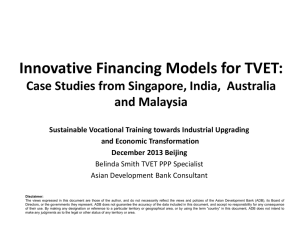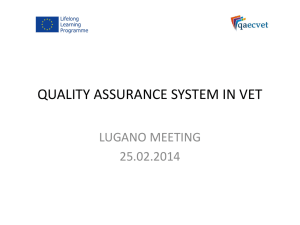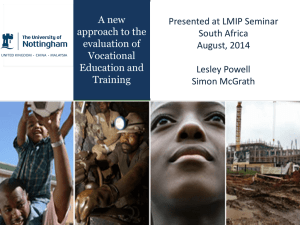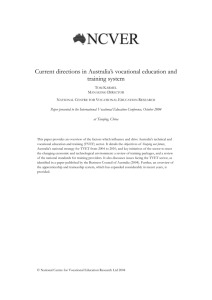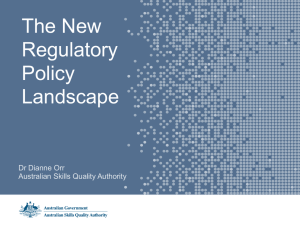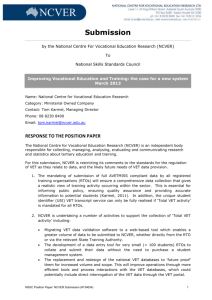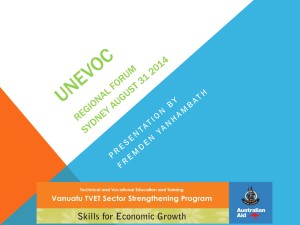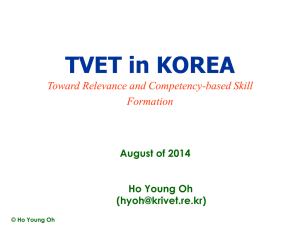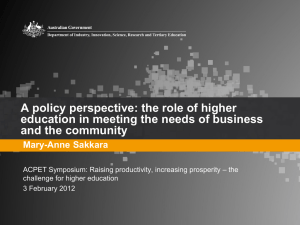Fostering applied research and innovation through industry
advertisement
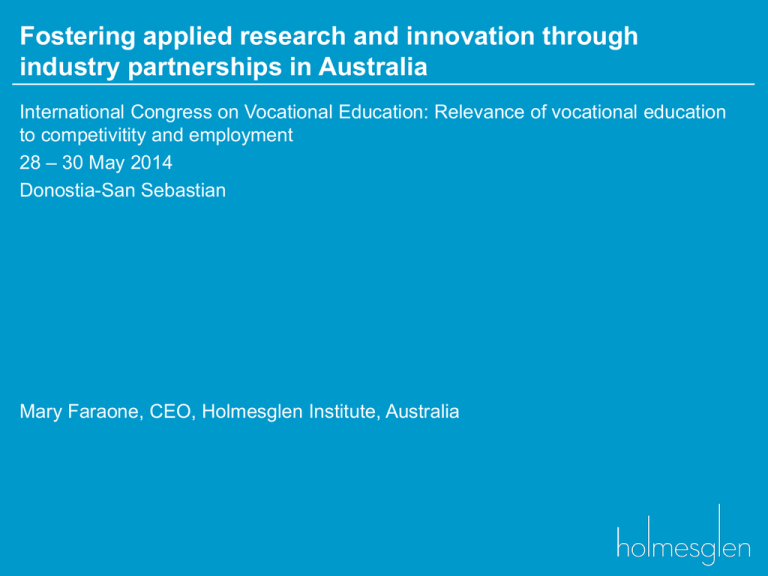
Fostering applied research and innovation through industry partnerships in Australia International Congress on Vocational Education: Relevance of vocational education to competivitity and employment 28 – 30 May 2014 Donostia-San Sebastian Mary Faraone, CEO, Holmesglen Institute, Australia Holmesglen at a glance 51,000+ course enrolments 43,700 domestic student enrolments 8,000 overseas student enrolments (inbound and offshore) 18,300 effective full time load 4% higher education 28% diploma and ad. diploma 57% vocational certificates 7% apprenticeships 3% senior secondary 1% non-award Source: internal unpublished data, 2013 13m+ student contact hours $162m total operating income 1400 staff $429m total assets Key Features of the Australian TVET system – mixed bag The good, the bad and the ugly Key Features of the Australian TVET system – mixed bag Internationally well respected and recognised National Training Packages – key feature Industry Skills Councils – develop National Training Packages Federated model however 8 separate jurisdictions with 8 different funding models Move from fully funded by government in 2008 to various competitive funding models across the 8 jurisdictions in 2014 National regulator – Australian Quality Skills Authority however various additional versions in the jurisdictions to manage funding contracts No clear vision for public TVET provision or providers Poor perception of TVET compared to higher education Decrease in paraprofessional qualifications due to competition of demand driven funding in higher education Ad hoc involvement in research and development TVET system is almost entirely excluded from Australian government innovation policy A snapshot of the Australian TVET system (2012) 2,110 training organisations delivered publicly funded vocational education and training (VET) – 61 TAFE institutes (publically owned providers) – 312 community providers – 1,817 private providers 1.9 million students enrolled in the public VET system, of which: – 64.7% at TAFE and other government providers – 20.4% apprentices and trainees – 83.3% studying part-time – 6.4% with a disability – 15.8% from a non-English speaking background – 51.5% male – 25.6% 19 years or younger, 17.1% 20-24 years, 36.7% 25-44, 20.2% 45 and over 12.5% of people aged 15 to 64 years participated in publicly funded VET – 33.4% of Australians aged between 15 and 19 years participated in VET Source: NCVER, 2013, Student and Courses 2012, NCVER, Adelaide. Innovation is….. Pure research is useless; innovation is gold Moodie, G 2006, Vocational education institutions' role in national innovation, Research in Post-compulsory Education, 11 (2), 131-140. Innovation, especially process and incremental innovation, depends on a skilled workforce……it is enterprises, not governments, which are at the heart of the innovation process. Enterprises take new ideas, turn them into a product or service and then market the result. In turn, they need the right people with the right skills and knowledge to help them do this. People are the innovators. Guthrie, H & Dawe, S 2004, Overview, in S Dawe (Ed.), Vocational Education and Training and Innovation: Research Readings, NCVER, 10-19. ……is the implementation of a new of significantly improved product [good or service], process, new marketing method or a new organisational method in business practices, workplace organisation or external relations. OECD 2005, Oslo Manual, 3rd Edn., OECD and European Commission, Paris. Innovation and the TVET system “..despite the weight of academic evidence from the innovation studies discipline the VET system is almost entirely excluded from Australian government innovation policy” Toner, P & Dalitz, R, 2012, Vocational Education and training: the ‘terra incognita’ of Australian innovation policy, Prometheus: Critical Studies in Innovation, 30(4), 411-426. Key innovations in Australian TVET system 2009: Training Packages – industry informed Australian Technical Colleges Flexible Learning Advisory Group OECD/CERI, 2009, Systemic Innovation in the Australian VET System: Country Case Study Report, OECD. Five years is a long time in TVET….. Training Packages Australian Technical Colleges Flexible Learning Advisory Group Innovation is systemic but innovative products, processes are a snapshot in time OECD/CERI Study conclusions….. Drivers of change Facilitators of innovation Barriers to innovation Weak Evaluation Culture “ There is a growing body of knowledge which has demonstrated that innovation happens at different levels and that employee (skilled worker) and user-driven innovation have an essential role to play in innovation processes. These reflections – especially pertinent for SMEs, could guide policies to redirect and vitalize systemic innovation in VET.” OECD/CERI, 2009, Systemic Innovation in the Australian VET System: Country Case Study Report, OECD. Applied research Basic research is experimental or theoretical work undertaken primarily to acquire new knowledge of the underlying foundation of phenomena and observable facts, without any participation application or use in Applied research is also mind. original investigation in order to acquire new knowledge. It is, however, directed primarily towards specific practical aim or objective. OECD, 2002, Frascati Manual, 6th Edn., OECD Publishing Fostering applied research Scholarly practice Boyer Model Scholarship policy and guidelines: – Organisational and social resources, including funding, time, opportunities for dialogue – Work practices that produce, share and validate scholarly outputs – Workplaces, developing a culture of scholarly practice and organisational responsiveness – Organisational and individual capacities ‘applied research and development is not something for which the VET system has a reputation, bit it’s occurring in many colleges. This is a specific but unharnessed VET capability which could be developed more fully to assist in the innovation capacity of the nation’ Whittingham, K 2003, Going Boldly into the Future: Skills and Australian High Technology Start-up Enterprises, NCVER. Scholarship – Boyer’s model Boyer advanced a redefinition of concept of scholarship as four separate yet overlapping functions. Type of scholarship Purpose Measures of Performance Discovery Build knowledge through traditional research • Publish in peer-reviewed forums. • Producing and/or performing creative work within established field. • Creating infrastructure for future studies. Integration Interpret and bring new knowledge to original research and make connections across disciplines • Preparing a comprehensive literature review. • Writing a textbook for use in multiple disciplines. • Collaborating with colleagues to design and deliver a core course. Application Apply knowledge to create new understandings and aid society and professions to address problems • Serving industry or government as an external consultant. • Assuming leadership roles in professional organisations. • Advising student leaders, thereby fostering their professional growth. Teaching Study teaching models and practices to achieve optimal learning • Advancing learning theory through classroom research • Developing and testing instructional materials. • Mentoring graduate students. • Designing and implementing a program level assessment system. TVET and industry Background Linkages Case studies TVET, industry, applied research and innovation How does it all come together? Case study: Victorian simulation alliance Founded in 2010 this ‘community of practice’ has developed into an innovation collaboration that fosters applied research to support the industry. Key activities: Facilitating ongoing professional development and education Scenario development and sharing Information dissemination Linking metropolitan, rural and regional areas Creating a cohesive voice and common language Best-practice identification and sharing Fostering inter-professional practice, collaboration and partnerships Facilitating inter-organisational research and projects Informing standard and policy setting Identifying opportunities and lobbying for funding Linking nationally and internationally. ....“Create an environment that fosters collegiality, collaboration, networking and sharing among those engaged in health professional simulation-based education and research.” Case study: Healthscope/Holmesglen partnership Establishment of private hospital on the Holmesglen Campus in conjunction with an Education Agreement and a joint Clinical Chair Conclusions/Recommendations Much activity is : Local Ad hoc Disconnected to policy and funding Not systemic Conclusions/Recommendations Gavin Moodie recommends a role for vocational education institutions in stimulating innovation if they take the following six steps: 1. 2. 3. 4. 5. 6. Emphasis innovation; eschew research Develop a distinctive role in the national innovation system Act locally, learn globally Form multiple partnerships Establish a national network of vocational education innovation institutes Act in the long term Moodie, G 2006, Vocational education institutions' role in national innovation, Research in Post-compulsory Education, 11 (2), 131-140. Conclusions/Recommendations To enhance the links between the VET sector and business innovation in Australia, Richard Curtain makes two suggestions: 1. Access to government research and developmental funding, focusing on processes and development rather than pure research, would bring the VET sector closer to business innovation. 2. Government research and development funding to the VET sector could be solely focused on small and medium sized enterprises. Curtain, R 2004, Innovation and vocational education and training: lessons from leading innovation systems, in Dawe, S (Ed.), Vocational education and training and innovation: Research readings, NCVER, 42-58.
